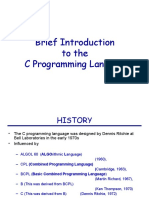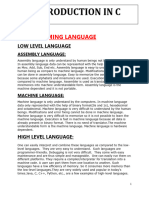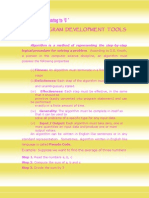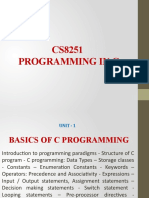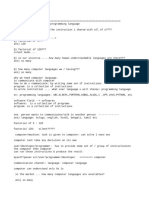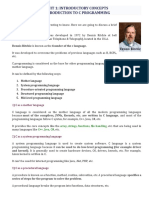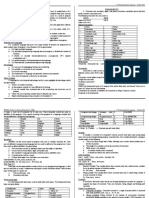0 ratings0% found this document useful (0 votes)
26 views13 pagesPuter Language
The document provides an overview of programming languages, categorizing them into low-level (machine and assembly languages) and high-level languages. It details the characteristics, advantages, and disadvantages of each type, focusing on C programming language, its syntax, constants, data types, and flow control statements. Additionally, it explains the process of writing, compiling, and executing a C program, along with the use of operators and control statements.
Uploaded by
Yash ShimpiCopyright
© © All Rights Reserved
We take content rights seriously. If you suspect this is your content, claim it here.
Available Formats
Download as PDF or read online on Scribd
0 ratings0% found this document useful (0 votes)
26 views13 pagesPuter Language
The document provides an overview of programming languages, categorizing them into low-level (machine and assembly languages) and high-level languages. It details the characteristics, advantages, and disadvantages of each type, focusing on C programming language, its syntax, constants, data types, and flow control statements. Additionally, it explains the process of writing, compiling, and executing a C program, along with the use of operators and control statements.
Uploaded by
Yash ShimpiCopyright
© © All Rights Reserved
We take content rights seriously. If you suspect this is your content, claim it here.
Available Formats
Download as PDF or read online on Scribd
You are on page 1/ 13
Chapter
Computer Language
Programming Languages
A programming language defines a set of instructions
that are compiled together or perform a specific task by
(PU. Each PL contains a unique set of keyword and
syntax, which are used to create a set of instructions.
‘These PLs vary in level of abstraction they provide from
the hardware. Based on level of abstraction they can
classified in 2 categories :
These are Low Level Languages and High Level
Languages. Low Level Languages are further divided in
to Machine language and Assembly language.
Low Level Languages (LLL)
The term low level means closeness to the way in which
the machine has been built. Low level languages are
machine oriented and require extensive knowledge of
computer hardware and its configuration,
Machine Language
Machine language is the only language that is directly
understood by the computer. It does not needs any
translator program. We also call it machine code and it is
written as strings of 1’s (one) and 0's (zero).
‘When this sequence of codes is fed to the computer, it
recognises the codes and converts it into electrical signals
needed to run it. eg., a program instruction may look like
this 1011000111101.
Itisnot an easy language for you to learn because of its
difficult to understand. Itis efficient for the computer but,
very inefficient for programmers. It is considered to the
first generation language. It is also difficult to debug the
program written in this language.
Advantage
The only advantage is that program of machine language
run very fast because no translation program is required
for the CPU.
Disadvantages
* Itis very difficult to program in machine language.
The programmer has to know details of hardware to
write program.
‘© The programmer has to remember a lot of codes to
write a program which may result in programming,
errors.
* Itis difficult to debug the program.
Assembly Language
‘The problem which we were facing in Machine Level
Language is reduced to some extent by the use of
human-readable code called Mnuemonics such as mov,
add, ete. Translator program is required to translate the
assembly language to machine language. This translator
program is called ‘Assembler’. Its considered to be a
second- generation language.
Advantages
© The symbolic programming of assembly language is
easier to understand and saves a lot of time and effort
of the programmer.
* It is easier to correct errors and modify program
instructions.
* Assembly language has the same efficiency of execution
as the machine level language. Because this is one-to-
fone translator between assembly language program
and its corresponding machine language program.
Disadvantages
‘One of the major disadvantages is that assembly
language is machine dependent. A program written for
‘one computer might not run in other computers with
different hardware configuration ie, itis not portable,
High Level Language (HLL)
In High Level Language, instructions are defined in
English words and logic of the problem irrespective of
the type of computer you are using.
©
Itis easy to understand and simple to maintain. Higher
level languages are the languages that use English
language words and mathematical symbols like +, ~, %,
/, ete. for its program construction.
High level language has to be converted to machine
language for the computer to understand. So, it needs
compiler or interpreter for translation.
eg. COBOL (Common Business Oriented Language) is
mostly suitable for business oriented language where
there is very little processing and huge output.
FORTRAN (Formula Translation) and BASIC (Beginners
All-purpose Symbolic Instruction Code) where very
large processing is required.
C Programming Language
Cis a general-purpose, procedural, imperative, high
level computer programming language developed at AT
and T’s Bell Laboratories of USA in 1972 by Dennis
M. Ritchie. C is a reliable, simple and east to use
language. It is a widely used programming language. It
was developed for the programming of the UNIX OS.
The C Character Set
A character denotes any alphabet, digit or special symbol
ie, Set of all valid characters that we can use in source
program for forming words expression and numbers.
It includes :
* Alphabets A,B, Y,Z (all uppercase)
2 (all lowercase)
« Digits 0,1,2,3,4,5,6,7,8,9
*# Special symbols ~1@#% &*()_
e>,.t/
‘+ White spaces _ Blank space, Carriage return, Tab and
New line.
C Constants
«The constants in C are the read only variables whose
value cannot be modified once they are declared in the
C program.
« We define the constants in C language using the
constants keyword.
Syntax const data_type var_name = value;
=I\00
Types of C Constant
C constants can be divided into two major categories
(i) Primary constants
(ii) Secondary constants - array, pointer, structure,
union etc,
Prep Guide MAH-MCA CET
Primary Constants
They areas follows as :
Integer Constant
‘# An integer constant must have atleast one digit.
# Itmust not have a decimal point.
« Itcan be either positive or negative.
# Ifno sign precedes an integer constant, itis assumed to
be positive.
+ Nocommas or blanks are allowed within an integer
constant.
« The allowable range for integer constants is ~ 32768 to
32767.
Real Constants
‘ Real constants are often called floating point constants.
‘* The real constants could be written in two forms —
Fractional form and exponential form.
A real constant must have atleast one digit.
Itmust have a decimal point.
It could be either positive or negative.
Default sign is positive.
‘No commas or blanks are allowed within a real
constant,
8
+32534 (Positive real constant)
426.0 (Positive real constant)
32.76 (Negative real constant)
‘© The exponential form is usually used if the value of the
constant is either too small or too large.
© Inexponential form the real constant is represented in
two parts.
© The part appearing before ‘e' is called mantissa and
following ‘e’is called exponent.
e.g, 0.000342 in exponential form can be represented as
3.4204
‘ Range of real constant in exponential form is
~ 3.4638 to 3.4038
Character Constants
A character constant isa single alphabet, a single digit or
a single special symbol enclosed within single inverted
commas.
eg., ‘A’ isa valid character constant whereas A is not.
C Keyword
Keywords are the words whose meaning has already
been explained to the C compiler. The keywords cannot
be used as variable names because if we do so, we are
Computer Concepts Computer Language
trying to assign a new meaning to the keyword, which is
not allowed by the computer.
£8, auto, break, case, char, const, continue, default, else,
exter, float, for, goto, int, long etc,
C Tokens
Ina C source program, the basic element recognised by
the compiler is the token. A token is a source program
text that the compiler does not break down into
component elements. C tokens includes keywords,
identifiers, constants, strings, special symbols and
operators.
fiers or Symbols are the names you supply for
variables, types, functions and labels in your program.
Identifier names must differ in spelling and case from
any keywords. We cannot use keywords as identifiers;
they are reserved for special use.
Rules for making identifier name
1. The first character of an identifiers must be an
alphabet or an underscore,
2. All characters must be either letters or digits.
3, There is no special characters are allowed except the
underscore “_",
4, There is no two underscores are allowed.
5. Don’t use keywords as identifiers.
6. Itis any combination of 1 to 31 characters.
Data Types in C Language
Each variable in C has an associated data type. It
specifies the type of data that the variable can store like
integer, character float etc.
Each data type requires different amounts of memory
and has some specific operations which can be
performed over it. The data types in C are class
follows as—
1, Primary data types in C They are also known as
the fundamental or primitive data types because
they are predefined in the C language. All the other
data types are derived from these data types. They
are-int, char, float and double.
2. Derived data types in C These are derived from
the primary data types. They are mainly of three
types-ie,, Arrays, Functions and Pointers.
3. User-defined data types in C These are defined by
user as per their requirement using the basic
primary data types and derived data types. They
are classified as structure, union and enumeration.
3
How to Write a First C Program
There are certain rules that are applicable to all C
programs and they are as follows :
1. InC program, each instruction written as a separate
statement.
2. The statement of a program must be written in the
sequence in which we want them to execute.
3. All statements should be written in lowercase
letters.
Blank space are not allowed in the variable name
but we can use blank spaces between two words to
improve readability of statement.
5, Statements should be in small case letters.
6, Every statement ends with a semicolon (;).
7. Semicolon is called statement terminator.
8, We can put the comment within a program by
using /*...*/.
9. Comments are not necessary to use in a program
but itis a good habit to use comments in a program.
Compilation and Execution of a C Program
1. Write a program using editor.
2. Save the file with C extension.
3. To compile the program, we can select compile
from compile menu and press enter or you can
press Alt + F9,
4, Itwill check the errors if program has any error it
will terminate the program then we can find out the
error and we can correct it. After correcting the
error we can compile the program again. After
compiling successfully it will create a object (.0bj)
file.
mapas
See tes [Remco | {ccna
(c)
[Object fe]
(oo)
5. Once the source program has been converted into
an object fle, itis still not in the form that we can
trun. The reason behind this is that there may be
some references to standard library functions or
user- defined functions in other object files, which
are compiled separately.
Therefore, these object files are to be linked together
along with standard library functions that are
contained in library files. To link owe object files,
select link from the compile menu.
© Prep Guide MAH-MCA CET
‘After this the obj file will be compiled withthe one of
‘or more library files. The result of this linking 2. [if expression)
process produces an executable file with .exe {
ee block of statements;
Object Object 1
ee | [3] — o es
{
‘block of statements;
1
Taare a Is
I 4, if expression)
ets {
block of statements;
6. .exe file isa stand alone executable file which can
direct execute from command prompt.
7. After pressing Alt + F9, it will complete the whole
process creating .obj and .exe.
8. To display the output of the program press Alt + F5.
C-Flow Control Statements
C provides two styles of flow control statements :
1. Branching, 2. Looping
Branching is deciding what actions to take and looping is
deciding how many times to take a certain action.
Branching
Branching is so called because the program chooses to
follow one branch or another. Following are the ways to
implement branching statements :
1. Using If Statement
‘This is the most simple form of the branching statements. It
takes an expression in parenthesis followed by a
statement or a block of statements. If the expression is
true, then the statement or block of statements gets
executed, otherwise these statements are skipped and the
statement or block of statements under else gets
‘executed.
Expression will be assumed as true if its evaluated value
is non-zero.
“f' statement can be defined in a program, in the following
forms :
1. [if (expression) statement;
oF
2. [iF (expression)
{
block of statements;
}
else if (expression)
block of statements;
}
else
}
[block of statements;
2, Conditional or Ternary Operator
inc (?:)
It is similar to the if-else statement as it follows the
algorithm as of if-else statement but it takes less space
and helps to write if-else statements in the shortest way.
It is also known as the ternary operator in Cas it
‘operates on three operands.
‘Syntax of conditional operator in C
Expression 1 ? Expression 2: Expression 3
It means~ If expression is true (ie., Non-zero), then the
value returned will be expression 2, otherwise the value
returned will be expression 3.
Switch Case Statement
© The switch statement is like a nested if... else
statement. It is mostly a matter of preference we use. It
can be slightly more efficient and easier to read.
* Syntax is as follows as :
switch (expression)
t
case constant 1:
‘statement 1 ;
break; /* optional */
Computer Concepts Computer Language
case constant 2 :
statement 2;
break) /* optional */
case constant n :
statement n;
break;
default :
statement;
)
Ifa condition is met in switch case then execution will,
not continue on the next case due to the usage of ‘break’
keyword.
Looping
Loops provide a way to repeat commands and control
how many times they are repeated. C provides a number
of ways to impliement loops.
1. While Loop
The most basic loop in C is the while loop. A while
‘statement is like a repeating if statement.
Like an if statement, if the test condition is true : the
statements get executed. The difference is that after the
statements have been executed, the test condition is
checked again. Ifitis still true the statements get
executed again. This cycle repeats until the test condition
evaluates to false.
Syntax is as follows as :
7* optional */
‘while (expression)
{
single statement;
or
block of statements;
2, For Loop
For loop is similar to while, its just written differently.
For statements are often used to process lists such a
range of numbers.
Syntax:
for (expression 1; expression 2; expression 3)
{
single statement;
or
block of statements;
In the above syntax :
Expression 1— Initialise v
Expression 2 — Conditional expression as long as this
condition is true, loop will keep executing.
Expression 3 — Expression 3 is the modifier which
may be simple increment/decrement of a variable.
3. Do...while Loop
Do....while is just like a while loop except that the text
condition is checked at the end of the loop rather than
the start. This has the effect that the content of the loop
are always executed atleast once.
Syntax :
do
{
single statement;
or block of statements;
)
while (expression);
Break and Continue Statements
C provides two commands to control the loops
(i) break - exit from loop or switch and transfers.
execution to statement immediately following the
loop or switch.
(ii) continue causes the loop to skip the remainder of
its body and immediately retest its condition prior
toreiterating.
eg., using continue statement
# include
main()
{
inti;
int} =6;
fot (i=0; i50)
indent printf (“a is between 50-55")
|| Operator (Logical OR)
| | operator returns true if either one or both condition
evaluates to true
eg, if(@==10||a<10)
! Operator (Logical NOT)
eg, if (flag)
The NOT operator is often used to reverse the logical
state of its operand. If condition is true, then it will make
it false and vice-versa.
if (! flag) equals to if (flag
Hierarchy of Operators
Type
Unary operatars
‘Arithmetic, modulus
‘Arithmetic addition and.
~ Equality operators
Bitwise AND, XOR, OR
Logical AND
~~ Logical Or
Conditional, Assignment,
Comma
Prep Guide MAH-MCA CET
2. Bitwise Operators
Operations on bits at individual levels can be carried out
using Bitwise operations in the C programming.
language. Bits come together to form a byte which is the
lowest form of data that can be accessed in digital
hardwares, The whole representation of a number is
considered while applying a bitwise operator.
‘The Bitwise operators supported by C language are
listed in the following table. Assume variable A hold a 60,
and variable B holds 13, then
Operator] Description Example
‘& [Binary AND Operator copies |(A & B) will give 12
a bit tothe result if it exists in | which is 0000 1100
both operands.
| [Binary OR operator copiesa |(A| B) will give 61
biti it exists in either |which is 0011 1101
loperand.
‘* [Binary XOR Operator copies (AB) will give 49
the bitif it is set in one |which is 0011 0001
loperand but not both.
~ [Binary Ones complement —_|(~A) will give -61
|Operator is unary and has the
effect of ‘lipping’ bits
Binary Left Shift Operator.
[The left operands value is
'moved left by the number of
bits specified by the right
loperand,
Binary Right shift Operator.
‘The left operands value is
moved right by the number of
bits specified by the right
operand.
which is 0111101
<< [Ac< 2 will give 240
‘which is 1111 0000
A>> 2will give 15
| which is 0000 1111
C-Variable Types
A variable is just a named area of storage that can hold a
single value (numeric or character). The C language
demands that we declare the name of each variable that
we are going to use and its type or class.
‘The programming language C has two main variable types :
Local Variables
© Local variables scope is confined within the block or
function, where it is defined. Local variables must
always be defined at the top of a block.
© When a local variable is defined, it is not initialised by
the system, we must initialise it ourself.
© When executing of the block starts, the variable is
available and when the block ends, the variable dies.
computer Concepts Computer Language
F xin()
\
inti=4;
it
if§>0)
{
printf ("iis % d\n”, i);
}
if >0)
{
int i = 100;
printf ("iis %d\n", i);
}
printf ("i is %d\n", i);
)
This will generate the following output
iis5
iis 100
iisS
« Here, ++ is called incremental operator and it increase
the value of any integer variable by 1. Thus, i++ is
equivalent to i =i + 1; as well as i—be equivalent to i
=H;
Global Variables
© Global variable is defined at the top of the program file
and it can be visible and modified by any function that
may reference it.
* Global variables are initialised automatically by the
system when we define them.
« Ifsame variable name is being used for global and
local variable then local variable takes preference in
its scope.
eg, inti=4; —_/* Global definition */
main()
{
int; /* Global variable */
fun(o);
printf (“value of i= %d\n",i);
inti=l0; —/* Local definition */
itt; /* Local variable */
printf (“value of i=%d \n”, i);
)
e
This will produce following result
value of i=11
value of
+ iin main function is global and will be incremented to
5. in func is internal and will be incremented to 11.
When control returns to main, the internal variable
will die and any reference toi will be to the global.
Functions
* A function is a self-contained block of statements that
perform a coherent task of some kind. Every ¢
program can be thought of as a collection of these
functions.
‘© Making functions is a way of isolating one block of
code from other independent blocks of code.
Functions serve two purposes
1. They allow a programmer to say : this piece of code
does a specific job which stands by itself and should
not be mixed up with anything else.
2. They make a block of code reusable, since a
function can be reused in many different contexts
without repeating parts of the program text.
© A function can take a number of parameters, do
required processing and then return a value. There
may be a function which does not return any value.
‘© When a function is defined at any place in the program
then it is called function definition. At the time of
definition of a function actual logic is implemented
within the function.
* A function declaration is usually declared at the top of,
a C source file or in a separate header file.
Passing Parameters to a Function
There are two ways to pass parameters to a function :
Pass by Value
This mechanism is used when we don’t want to
change the value of passed parameters.
© When parameters are passed by value then function in
C create copies of the passed variables and processing
will be done on these copies variables.
ass by Reference
© This mechanism is used when we want a function to
do the changes in passed parameters and reflect those
changes back to the calling function.
In this case, only addresses of the variables are passed
toa function, so that function can work directly over
the addresses,
b)
Structured Data Types
Some structured data types are given below
1. Arrays 2. Structure 3. Union
Arrays
Anarray is a data structure, process multiple elements
with the same data type.
‘+ Bach element of the array is given a number by which
we can access that element.
* For an array of 100 elements, the first element is 0 (zero)
and the last is 99. This indexed access makes it very
convenient to loop through each element of the array.
eg
4. String
#include
main()
{
int af5];
printf (“value in array %d\n", ali);
)
)
Output is
value inarray0 —valueinarray1 —_value in array 2
value in array 3 value in array 4
Address of each element in an array
Array elements occupy consecutive memory locations.
#include
main ()
(
int af5];
inti;
for
=0;i< 5; i++)
O;i <5; it+)
printf (“value in array %d and address is %
lu\n", afi], & ali);
}
Prep Guide MAH-MCA CET
Output is
‘Value in array 0 and address is 631656
value in array 1 and address is 631660
value in array 2 and address is 631664
value in array 3 and address is 631668
value in array 4 and address is 631672
Hence, in array the values are stored like this
alo} aft} al2] al)
31656631660 631664 631668
ald]
631672
Multidimensional Array
In C language, one can have arrays of any dimensions,
To understand the concept of multidimensional arrays,
let us consider the following 45 matrix
Column number {j]
Ocoee oleae
Row number [i] | #0 | #1 | 42 | a3 | aos
Tmo | a [me [as | ae
2,0 | aaa | 42.2 | 42.3 | ara
0 | aor | a2 [as | ase
To access the particular element from the array we have
to use two subscripts one for row number and other for
column number. The notation is of the form afi]fj], where
{stands for row subscripts and j stands for column
sub-scripts.
Thus, a[0}{0] refers to the first element of the two-
dimensional array and so on and a[0]{0] is same as 4,9.
Below given are some typical two-dimensional array
definitions
float table [50] [50];
char line [24] [40];
Alternatively, we can also define and initialise the array as
follows
int values [3] [4]
11,2,3,4)
5,6,7,8)
{9, 10, 11, 12}
i
Here, the value in first pair of braces are initialised to
elements of first row and so on.
Pointers
Pointers are widely used in programming ; they are used
to refer to memory location of another variable without
using variable identifier itself. They are mainly used in
linked lists and call by reference functions.
Computer Concepts Computer Language
o
Pointer Declaration
Declaring pointers variable, we need to used ‘*’ operator
(indirection /dereferencing operator) before the variable
identifier and after data type.
Syntax
Datatype * variable;
Simple variable is a normal variable that is used to store
the value but pointer variable is used to store the address
of any variable.
eg, include
int main( )
{
chara
char *ptr;
printf ("%c\n", a);
pir=&a;
printf ("%p\n” , ptr);
*ptr='d’;
printf ("%ec\n”, a);
return 0;
}
Output
b
0014FB97
d
Address Operator
Address operator ({&) is used to get the address of the
operand. For example, if variable x is stored at location
100 of memory; & x will return 100.
x a
if 5 and *a=éx,then 100
100 1000
(Variable x) (Pointer variable)
Pointers and Functions
Pointers can be used with functions. The main use of
pointers is call by reference functions. Call by reference
isa type of function that has pointer(s) (reference) as
parameters to that function. All calculation of that
function will be directly performed on referenced
variables.
eg, include
1, void doubleit (int *num)
{ Pointer variable
2.*num*=2; //*num=*num*2
}
3. int main ()
{
4. int number = 2;
5. doubleit (& number); //pass the address
of variable
6, printt ("%d", number);
7. return 0;
)
Output 4 Here in line 1, we are declaring ‘doubleit’
function. In line 4, the variable number is declared and
initialised to 2. In line 5, the function ‘doubleit is called.
Pointer to Arrays
Array identifier is a pointer itself. Therefore, & notation
should not be used with arrays.
When working with arrays and pointers altoays remember the
{following :
1, Never use & for pointer variable pointing to an
array.
2. When passing array to function, we don’t need * for
your declaration.
Constant Pointers and Pointers
to Constant
Consider the following three declarations assuming that
char_A has been defined asa type char variable
1. const char * myptr =& char_A;
2. char* const myptr =& char_A;
3. const char * const myptr = & char_A;
‘These are all three valid and correct declarations. Each
assigns the address of char_A to a character pointer.
Const char * myptr = char_A;
This first declaration declares a pointer to a constant
character. We cannot use this pointer to change the value
being pointer to:
eg, charchar_A=‘A’;
const char * myptr=é char_A;
*myptr="J; // error-can’t change value of
1/ sexypte
Char *const myptr = & char_A;
‘The second declaration declares a constant pointer toa
character, The location stored in the pointer cannot
change, We cannot change, where this pointer points.
eg, char char_A='A'
char char.
char * const myptr = & char_A;
‘myptr = & char_B; //error—can’t change adciress
Prep Guide MAH-MCA CET
© :
Const char * const myptr = & char_A;
‘The third declaration declares a pointer to a character,
where both the pointer value and the value being pointer
at will not change.
Strings
In C language, strings are stored in an array of char type
along with the null terminating character “\0” at the end.
* In other words, to create a string in C, we create an
array of chars and set each element in the array to a char
value that makes up the string,
‘© When sizing the string array, we need to add plus one
to the actual size of the string to make space for the null
terminating character, “\0”.
Syntax char fname [4];
'* The above statement declares a string called fname that
can take upto 3 characters. It can be indexed just as a
regular array as well.
eg, frame[]=('t,'w, 0h,
[Character [| t | w] 0 [ wo
[acctcode | 6 [19 | a1 | 0
The last character is the null character having ASCIL
value zero.
+ If we wanted to print a string from a variable, such as
our fname string above we can do this.
eg., printf (“First Name: %s”, fname);
+ We can insert more than one variable. Use %s to insert a
string and then list the variables that go to each %s in
our string, we are printing.
Length of String
‘© Use the strlen function to get the length of a string
‘minus the null terminating character.
Syntax int strlen (string);
* If we had a string and called the strlen function on it we
could get its length.
eg, char fname [30] = ("Bob");
int length =strlen (fname);
+ This would set length to 3.
Concatenation of Strings
© The strcat function appends one string to another.
Syntax char’ strcat (string 1, string 2);
* The first string gets the second string appended tc
for example, to print a full name from a first and last
name string we could do the following
char fname [30] = ("Bob");
char Iname [30] = |“by”);
printf ("%s", strcat (fname, Iname));
‘© The output to this snippet would be “Bobby”.
Compare two Strings
+ Sometimes we want to determine if two strings are the
same. For this we have the stremp function.
Syntax int stremp (string 1, string 2);
# The return value indicates how the two strings relate to
cach other. If they are equal, stremp returns 0.
‘© The value will be negative if string 1 is less than string 2
or positive in the opposite case.
Copy Strings
To copy one string to another string variable, we use the
strepy function. This makes up for not being able to use
the “=” operator to set the value of a string variable.
Syntax _strepy (string 1, string 2);
Converting Uppercase Strings to
Lowercase Strings
‘This function is not the part of ANSI standard.
Syntax strlwr (string);
Structure
Structures in C are used to encapsulate or group together
different data into one object.
We can define a structure as shown below
struct object
{
char id [20];
int xpos;
int ypos;
i
‘© The variables we declare inside the structure are called
data members.
Initialising a Structure
* Structure members can be initialised when you declarea
variable of your structure.
Sample code
struct object playerl = {“player 1”, 0, 0};
© The above declaration will create a struct object called
player 1 with an id equal to “player 1”, xpos equal to 0
and ypos equal to 0.
# To access the members of a structure, we use the “.”
(scope resolution) operator.
Sample code
struct object player1;
player 1. id = “player”;
player 1.xpos =0;
player L.ypos =0;
EXERCISES
= Chapter Challenges
41. A set of rules for telling the computer what
operations to perform is called as
(@) procedural language — (b) language
(©) command language (4) programming language
2. Languages which can easily interact with the
hardware are called
(@) High level languages (b) Low level languages
(c) Middle level languages (d) All of these
3. The use of combination of 1's and 0's is feature of
which of the following type of computer language?
(@) High level language
(&) PASCAL
(6) Machine language
(@) COBOL
4, The function of an assembler is
(a) to convert basic language into machine language
(©) to convert high level language into machine
language
(© to convert assembly language into machine
language
(@) to convert low language into assembly level
language
5. Computer programs when written in a high level
programming language, the human readable
version of a program is called as.
(a) word size (b) Source code
(©) instruction set () Application
6. Which of the following contains specific rules and
words that express the logical steps of an
algorithm?
(a) Flow chart
(b) Syntax of the programming language
(6) Program
(d) Logical chart
7. From the following statements choose the correct
one
{a) use of goto makes the debugging task easier
(b) use goto when you want to jump out of a nested
loop
(©) use of goto enhances the logical clarity of a code
(@) never use goto
8. The primary reason for developing C language
was to treat it as a
(a) system programming language
(b) general purpose language
(©) data processing language
(a) None of the above
9. What is the difference between following
declarations?
extern int fun( );
(a) Both are identical
(b) No difference, except exter int fun( ), is probably
in another file
(c) int fun( ); is overrided with extern int fun( );
(d) None of the above
2. int fun( );
10. In the following program fragment, s, b are two
+b; s=b-s D=b-s,
What does it intend to do?
(a) Transfer the contents of s to b
(b) Transfer the contents of b tos
(©) Exchange (swap) the contents of s and b
(@) Negate the contents of s and b
11, From the following, choose the correct statement
(@) An identifier may start with an underscore.
(b) An identifier may end with an underscore.
(© The number of significant characters in an
identifier is implementation dependent.
(d) All of the above
12, From the following, choose the correct statement
(a) Constant expressions are evaluated at compile
time
(©) String constants can be concatenated at compile
time
(©) size of array must be known at compile time
(d) All of the above
413. If we arrange the operators !,| |,<, =, in an
ascending order of precedence, which of the
following is the correct choice?
@
You might also like
- Brief Introduction To The C Programming LanguageNo ratings yetBrief Introduction To The C Programming Language174 pages
- Program Life Cycle: Steps To Follow in Writing or Creating A ProgramNo ratings yetProgram Life Cycle: Steps To Follow in Writing or Creating A Program4 pages
- Programming For Problem Solving - Intro - PPTXNo ratings yetProgramming For Problem Solving - Intro - PPTX76 pages








